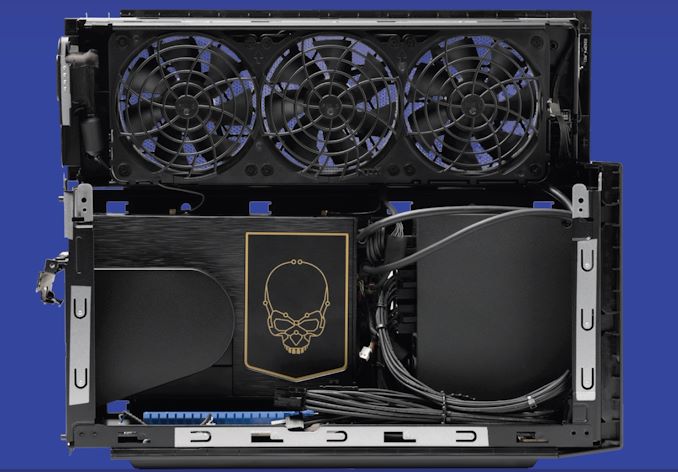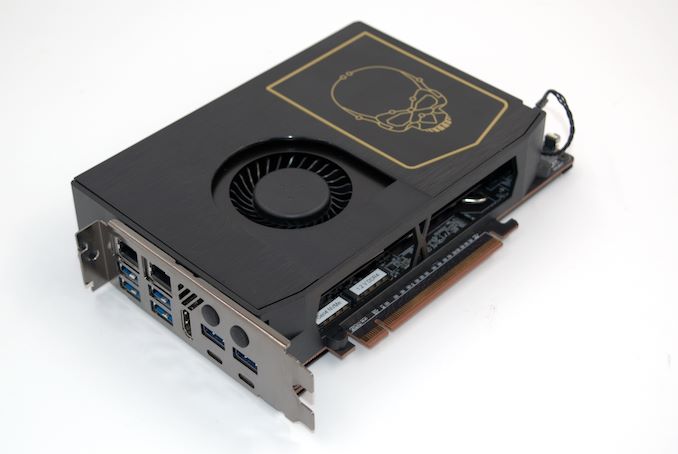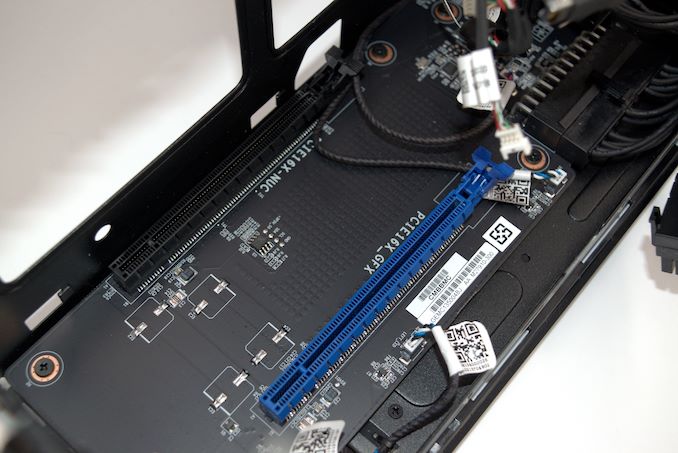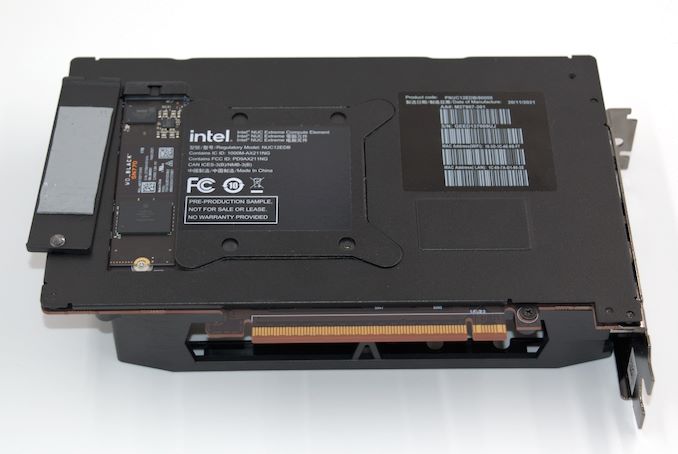The Intel NUC12 Extreme Dragon Canyon Preview: Desktop Alder Lake Impresses in SFF Avatar
by Ganesh T S on February 24, 2022 10:45 AM EST- Posted in
- Systems
- Intel
- NUC
- NUC12
- Dragon Canyon

Intel kick-started a form-factor revolution in the early 2010s with the introduction of the ultra-compact NUCs. The systems were meant to be an alternative to the tower desktops used in many applications where the size, shape, and the system capabilities were mostly unwarranted. The success of the NUCs enabled Intel to start reimagining the build of systems used in a wider range of settings.
More recently, the introduction of the Skull Canyon NUC in 2016 was Intel's first effort to make a gaming-focused SFF PC. And desktop-focused Compute Elements (essentially, a motherboard in a PCIe card form-factor) launched in early 2020 meant that full-blown gaming desktops could credibly come under the NUC banner. In the second half of 2020, the Ghost Canyon NUC9 – the first NUC Extreme – made a splash in the market with support for a user-replaceable discrete GPU. Ghost Canyon was extremely impressive, but the restrictions on the dGPU size and high-end pricing were dampeners. Intel made some amends with the NUC11 Extreme (Beast Canyon), using a special Tiger Lake SKU with a 65W TDP and comparatively competitive pricing.
The introduction of Alder Lake and its desktop-first focus has enabled Intel to prepare a new flagship in the NUC Extreme lineup barely 6 months after the launch of the Beast Canyon NUC. The new Dragon Canyon platform was briefly teased at the 2022 CES, with the promise of a Q1 launch. Intel is keeping up its word with the launch of a number of NUC12 Compute Elements and NUC12 Extreme Kit SKUs. Today, we are having a detailed look at what the NUC12 Extreme brings to the table, particularly in comparison to the NUC11 Extreme. The recent introduction of Windows 11 means that our benchmarks comparison set is currently limited - today's preview does not deal with any systems other than the NUC12 Extreme and NUC11 Extreme. A subsequent follow-up review will deal with gaming benchmarks (using dGPUs) and more comparison points with other SFF PCs in the market.
Introduction and Product Impressions
Intel's lineup of gaming-focused NUCs started with the Performance series (Skull Canyon NUC6i7KYK and Hades Canyon NUC8i7HVK), before moving up the ladder to the Extreme series (Ghost Canyon NUC9i9QNX). At the 2021 Computex, the Beast Canyon NUC took over the flagship mantle and brought about some important updates over the Ghost Canyon NUC:
- Support for 65W desktop-class CPUs in the Compute Element (compared to the 45W mobile workstation-focused CPU in the Ghost Canyon's Compute Elements)
- Increased chassis dimensions to accommodate larger discrete GPUs
- 10nm Tiger Lake CPU with new micro-architectural improvements for performance and power-efficiency
- Support for a richer set of I/Os (including PCIe Gen 4)
The teaser for the Dragon Canyon NUC at the 2022 CES brought in even more impressive features to the same form-factor - aspects that we are now able to confirm with a sample in hand:
- Support for 65W user-replaceable (socketed) desktop-class CPUs in the Compute Element (compared to the soldered CPU in the Beast Canyon's Compute Element)
- Alder Lake CPU manufactured in Intel 7 with new micro-architectural improvements for performance and power-efficiency, including hybrid performance and efficiency cores
- Support for faster I/Os (including PCIe Gen 5, PCIe 4.0 x8 equivalent bandwidth between the CPU and the PCH, and 10GbE wired networking support)
- Support for dual LAN ports (10GbE + 2.5GbE) in select SKUs, and better ports variety in the front - a Type-C and a Type-A USB 3.2 Gen 2 port instead of two Type-A ones in the Beast Canyon
A minor retrogression is the absence of support for PCIe lane bifurcation in the baseboard - while Beast Canyon's PCIe x16 dGPU slot could potentially be used in a x8 / x4 / x4 configuration, the Dragon Canyon's Edge Cove baseboard has no such support. The chassis still retains the M.2 22110 compartment on the underside, but there is no PCIe slot behind it.
Intel supplied us with an engineering sample of the high-end SKU in the Dragon Canyon line - the NUC12DCMi9 sporting the NUC12 Extreme Compute Element (NUC11EDBi9). This Compute Element is housed in a 357mm x 189mm x 120mm chassis - essentially the same one used in the NUC11 Extreme (Beast Canyon). Traditionally, NUCs have been associated with the ultra-compact form-factor (100mm x 100mm in a 0.63L or 0.42L chassis). The introduction of the Skull Canyon and subsequent Hades Canyon NUCs created yet another class of 0.7L to 1.2L NUCs, and the 2020 Ghost Canyon took it up to approximately 5L. The need to accommodate the cooling solution of a more powerful Compute Element, along with the ability to accept large dGPUs contribute to the 8L volume of the Beast Canyon and Dragon Canyon NUC chassis. This is still within the realm of SFF PCs - an adult can still single-handedly carry the unit around. Other important SFF aspects such as the in-built PSU are also carried over from the Beast Canyon NUC.
Intel's NUC lineup has traditionally included board and kit variants, allowing its partners to provide value additions (such as a passive chassis or additional I/O ports in the end system). Kits (other than the ones that come with a pre-installed OS) require the end-user to add storage, DRAM, and install an OS to complete the system. Intel plans to sell two varieties of the Dragon Canyon NUC Kit - the NUC12DCMi9 and the NUC12DCMi7. However, OEMs and end-users can also build their own NUC12 system based on the following components:
- Compute Element (NUC12EDBi9 or NUC12EDBi7 for the consumer market, and the vPro-capable NUC12EDBv9 or NUC12EDBv7 for the professional market)
- Baseboard (or backplane)
- Chassis
- PSU
- DRAM (up to 2x DDR4-3200 SODIMMs)
- Non-volatile storage
- Discrete GPU (optional)
An off-the-shelf Dragon Canyon NUC12DCM kit leaves only the DRAM, non-volatile storage, and discrete GPU to the choice of the end-user. Even though the Compute Element sports a LGA1700 socket, the two Compute Elements being sold in t he market come with the processor pre-installed (either Core i9-12900 or Core i7-12700). Prior to the platform analysis and overview of our review configuration, let's take a look at the pre-decided components in the above list.
NUC12 Compute Element
The NUC12DCMi9 we are reviewing today comes with the NUC12DEBi9 NUC12 Extreme Compute Element. It comes with a socketed processor - the Core i9-12900. This belongs to the Alder Lake (12th Generation) family, and has a 8C + 8c / 24T configuration with a 65W TDP. It can turbo up to 4.7 GHz. This Compute Element belongs to the series that started with the NUC9 generation, re-imagining the traditional motherboard in a discrete PCIe x16 card form-factor.
The Compute Element comes with a cooling shroud containing a single fan and three M.2 heat-sinks with thermal pads pre-attached. While two of those heat-sinks are in the side with the fan, the other is on the rear, behind the processor. The rear slot supports only M.2 2280 SSDs, and is connected directly to the processor. The two slots directly under the cooling shroud are PCH-connected ones. On the extreme right, we have the two SODIMM slots that can operate at speeds of up to DDR-3200 for DIMMs up to 64GB in total. These are vertical slots (compared to the horizontal ones in the NUC9 Compute Elements), and free up valuable space that gets taken up by the M.2 slots. It must be noted that the socketed processor requires slightly larger board estate - resulting in the movement of one of the three M.2 slots in the Driver Bay (Beast Canyon) Compute Element to the rear in the Dragon Canyon. The gallery below provides additional photographs of the Compute Element and the cooling shroud.
The NUC12DCMi9 comes with two Thunderbolt 4 ports, a 2.5G Ethernet port, a 10G Ethernet port, a HDMI 2.0b display output, and six USB 3.1 Gen 2 Type-A ports in the rear. There are two USB 3.2 Gen 2 ports (one Type-A and one Type-C), a 3.5mm stereo headset jack, and a SDXC slot with UHS-II support in the front. The front I/Os are enabled by a daughterboard that connects to the headers in the Compute Element. The Compute Element has its own power connection to the PSU.
Eden Cove Baseboard
The baseboard used in the Dragon Canyon (code name Eden Cove) is an evolutionary update to the Monster Cove board used in the Ghost Canyon.
The PCIe lanes are now Gen 5, but they drop the x8 / x4 / x4 bifurcation capabilities designed into the previous generation.
Chassis and PSU
The NUC12DCMi9 chassis has the same 'ease' of installation as the previous generation Extreme NUC. The dimensions allow the installation of dual slot GPUs up to 12" in length. The included 650W 80+ Gold internal PSU also supplies a 8-pin and a 2x6+2-pin connector for the GPU. The chassis can be disassembled by removing the four screws to dislodge the rear cover, and popping out the side panels.
The top panel with the three fans rests on a hinge. The embossed directions in the frame helpfully guide the user to open it up. This is essential to get access to the Compute Element and remove its shroud to install the RAM and storage.
Despite the plastic framing in the front panel, the metal-based construction in other areas gives the chassis a premium look and sturdy feel. The Beast Canyon NUC chassis also features customizable RGB underglow lighting, as well as a replaceable RGB front logo. While cable management is not an issue by itself, disassembling the NUC and reassembling is challenging because of the limited space between the PSU and the Compute Element. The myriad connections between the Compute Element and the daughterboard / front panel can't be easily kept separate from the PSU cables. Fortunately, most users only need to worry about the dGPU installation. The scope for trouble here again comes not from a cable management perspective - rather, the USB 3.2 Gen 2 header connection cables to the daughterboard tend to get loose and make the front port operate at USB 2.0 speeds. These issues existed in earlier NUC Extreme Kits also, but the absence of an update to the chassis design means that these issues remain unaddressed.
The front USB ports are recessed, and given their Type-A nature, figuring out the correct orientation to plug in the peripherals is a bit of a hit or miss. Certain keyboard / mice receivers can end up being completely inside the recess, making it challenging to remove them when the other USB slot is also occupied. The placement of the PSU AC receptacle on the top end of the chassis means that the heavy AC power cord could potentially create cable management issues. In both these aspects, the Ghost Canyon NUC chassis had a much better design.
The configuration of our review sample of the NUC12DCMi9 was completed with the following components:
- 2x Mushkin Redline 4S320NNNF32G for 64GB of DRAM
- 1x Western Digital WD_BLACK SN770 1TB M.2 2280 SSD
The presence of a desktop-class CPU in the system means that the Beast Canyon NUC should easily be able to support powerful GPUs - an aspect we will discuss in a future article. Today, we look at the Dragon Canyon NUC with the minimum required additional components. In the next section, we take a look at the full specifications of our configured review sample, followed by a detailed platform analysis along with some notes on our setup experience.





















38 Comments
View All Comments
thestryker - Thursday, February 24, 2022 - link
So you basically want a bigger case? That's the only way you'd get what you're looking for cooling wise because you have to account for the baseboard and power supply. I believe the DAN Case A4 is the only ITX case on the market smaller than the Intel NUC 11/12 Extreme (I'd assume there are probably knockoffs of this case which might be as well). As for the cooling there's a shroud which goes over the Element to draw air in from the back of the case for CPU cooling and the three fans at the top pull air out. There's nothing "random" about how they designed the cooling nor is it "off the shelf".For CPU heavy workloads I definitely wish they'd have a better cooling solution as they seem limited by their choice to utilize the compute element. I think the only way to solve this would be by doing a completely custom board setup, but I also highly doubt this would be financially viable.
Operandi - Thursday, February 24, 2022 - link
A larger case isn't need, just use the space more intelligently. The compute board is using a super compact heatsink with a blower fan (notebook cooling components), the case itself just has fans exhausting the hot air like any regular case. Its a lazy repackaging of components that already exist into a new form fact that offers zero benefits over what you can already accomplish with ITX.Repackage all of it so you are using all that active cooling to push the air through a passive heatsink, easily accomplished given how little power this uses. The rest of the case size and cooling would be dictated by how much space, cooling, and power is required for the GPU.
thestryker - Thursday, February 24, 2022 - link
You can't use top to bottom while using the compute element, and the PSU is located at the front of the case so you can't use front to back either. So you'd have to increase the width or height to be able to move the PSU out of the way for a front to back airflow which would make the case larger than it is now.Operandi - Thursday, February 24, 2022 - link
Only if you look at it in the narrow confines of how its setup now. Even with the compute element there are enormous ways you could achieve a top to bottom layout. PSU can go anywhere and be any form factor and completely external for lower power variants. Frankly I don't get why there are power cables at all side from for the GPU, power for the compute should be carried via the baseboard.thestryker - Thursday, February 24, 2022 - link
Name *one* way you could still utilize the compute element with the baseboard that also has an externally accessible M.2 slot with a top/bottom airflow setup. Now you want them to have a proprietary 650W gold PSU made forjust the enthusiast class NUC? There are *no* low power variants of the *enthusiast* NUC as they have a ton of regular NUCs to fit that bill. The compute element adheres to PCIe so they should redesign that just for this unit to fit the extra power consumption?
It doesn't seem that you actually understand how any of the components for these units work and just don't like the setup.
QChronoD - Friday, February 25, 2022 - link
If they are going to go through the trouble of making a custom baseboard for the compute module to plug into, it wouldn't have been that much more difficult to have the connectors positioned for the ATX and GPU power outputs on the PSU. Also likely could have flipped the compute board so that it was back to back with the GPU and then have a larger fan directly drawing air in from the outside of the case.thestryker - Friday, February 25, 2022 - link
Flipping the compute element has been the most suggested thing ever since Ghost Canyon, and Intel has never addressed this as far as I know. In the case of the enthusiast NUCs this would be the easiest and most obvious change, but it hasn't happened. I can't think of a logical reason not to do it, but it must have something to do with the other applications they're used in at the enterprise level.Operandi - Monday, February 28, 2022 - link
Name one? You want me to verbally draw you a mental image? Look at what systems like the NZXT H1 are able to do with top/down layout using ITX. The limiting factor is going to be where the ports exit the system because of the compute element but thats just another problem with how this is designed.Is the PSU supplying anything other than 12v? I doubt it, and if it is it shouldn't be. And yeah design a custom one its not hard and Intel is a huge company. Its all proprietary anyway and we already know this is going to be insanely expensive anyway so they have no excuse.
What exactly is the point of them using PCI-e for the compute element again? Just so they don't have to design and manufacture a purpose built connector for their entirely proprietary form factor? It certainly adds zero functionality to the system.
Dug - Friday, March 11, 2022 - link
nzxt h1 is one of the worst cooling cases around, that is what you call garbage. The aio would not be able to handle this chip. Air in from sides and out one 92mm fan is not a good design.The cooling in nuc is actually very good for what it is. The shroud separates the hot air from the gpu from the cpu, which is usually the problem in itx cases. Even those that use pci-e riser to put graphics card on the other side, no one actually isolates the compartments, which ends up over heating some other component like an ssd on the back of the motherboard. But the extension itself is troublesome and has shown to be more hassle than it's worth.
Dug - Friday, March 11, 2022 - link
I agree with a custom power supply. Look at what Apple did in the iMac pro. 8 to 18-core xeon, 5k display, Radeon Pro Vega 56, speakers, TB, etc, all from a super slim power supply built into the monitor. All one cable, no power brick. The archaic model of giant atx power supplies with thick cables going everywhere needs to go away.